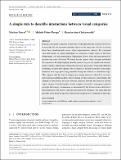Files in this item
A simple rule to describe interactions between visual categories
Item metadata
| dc.contributor.author | Poncet, Marlene | |
| dc.contributor.author | Fabre-Thorpe, Michele | |
| dc.contributor.author | Chakravarthi, Ramakrishna | |
| dc.date.accessioned | 2020-07-20T14:30:06Z | |
| dc.date.available | 2020-07-20T14:30:06Z | |
| dc.date.issued | 2020-12-31 | |
| dc.identifier | 268872924 | |
| dc.identifier | 1564ef48-046d-4f10-824a-f2be27e01151 | |
| dc.identifier | 85088104001 | |
| dc.identifier | 000567153200001 | |
| dc.identifier.citation | Poncet , M , Fabre-Thorpe , M & Chakravarthi , R 2020 , ' A simple rule to describe interactions between visual categories ' , European Journal of Neuroscience , vol. 52 , no. 12 , pp. 4639-4666 . https://doi.org/10.1111/ejn.14890 | en |
| dc.identifier.issn | 0953-816X | |
| dc.identifier.uri | https://hdl.handle.net/10023/20291 | |
| dc.description.abstract | Humans can rapidly categorise visual objects when presented in isolation. However, in everyday life we encounter multiple objects at the same time. Far less is known about how simultaneously active object representations interact. We examined such interactions by asking participants to categorise a target object at the basic (Experiment 1) or the superordinate (Experiment 2) level while the representation of another object was still active. We found that the “prime” object strongly modulated the response to the target implying that the prime's category was rapidly and automatically accessed, influencing subsequent categorical processing. Using drift diffusion modelling, we show that a prime, whose category is different from that of the target, interferes with target processing primarily during the evidence accumulation stage. This suggests that the state of category‐processing neurons is altered by an active representation and this modifies the processing of other categories. Interestingly, the strength of interference increases with the similarity between the distractor and the target category. Considering these results and previous studies, we propose a general principle that category interactions are determined by the distance from a distractor's representation to the target's task‐relevant categorical boundary. We argue that this principle arises from the specific architectural organisation of categories in the brain. | |
| dc.format.extent | 28 | |
| dc.format.extent | 1132769 | |
| dc.language.iso | eng | |
| dc.relation.ispartof | European Journal of Neuroscience | en |
| dc.subject | Category interactions | en |
| dc.subject | Drift-diffusion model | en |
| dc.subject | Priming | en |
| dc.subject | Representation similarity | en |
| dc.subject | Visual categorisation | en |
| dc.subject | BF Psychology | en |
| dc.subject | DAS | en |
| dc.subject.lcc | BF | en |
| dc.title | A simple rule to describe interactions between visual categories | en |
| dc.type | Journal article | en |
| dc.contributor.institution | University of St Andrews. School of Psychology and Neuroscience | en |
| dc.identifier.doi | 10.1111/ejn.14890 | |
| dc.description.status | Peer reviewed | en |
This item appears in the following Collection(s)
Items in the St Andrews Research Repository are protected by copyright, with all rights reserved, unless otherwise indicated.

